India’s economic robustness hinges on the effective movement of goods and raw materials throughout the nation. This is facilitated by a resilient transportation infrastructure encompassing rail, road, air, and waterways. Simultaneously, the Goods and Services Tax guarantees that businesses utilizing these modes of transportation contribute their equitable portion of taxes.
What is an e-way Bill?
Simply put, it is an electronic permit generated on the GST portal that details the quantity and unit measurement of goods in transit within a state or interstate. It is a requirement for all transporters moving goods worth more than Rs. 50,000 to have an electronic permit. The e-way bill generated for the transportation of goods is valid across all states and union territories in India.
The e-way bill must always be generated before goods worth more than Rs. 50,000 are shipped. The permit should include details of the shipped goods, the transporter handling the goods while in transit, the recipient and the consignor. While the permit is generated for the supply of goods, it is also used for non-supply transactions like export/import, return of goods, or completely kicked-down supply.
Who should generate an e-way Bill?
It’s common for consignments to move from one place to another before they reach their final destination. The transportation that takes place in this case may involve multiple vehicles as some goods go to different locations. If that were to happen, the transporter would have to provide the vehicle details using the Update Vehicle on the e-way bill portal to indicate the specific vehicle used to transport a given consignment.
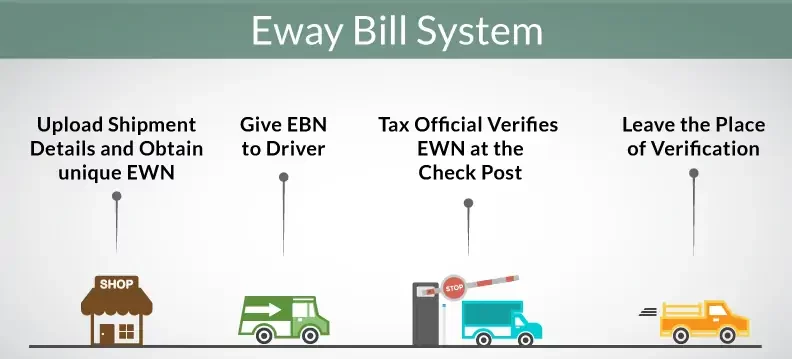
Any registered person who may be a consignor, recipient, or transporter can generate an e-way bill to transport goods if it is done through their own or hired means of transport. If an unregistered person supplies the goods, the recipient must follow the compliance procedure. The transporter can also generate the e-way bill if the recipient and supplier fail to develop it.
Likewise, a consolidated e-way bill detailing the multiple e-way bills for the multiple consignments in transit is to be generated. Nevertheless, the transporter transporting multiple consignments for various recipients in one vehicle has to have a consolidated e-way bill.
The e-way bill comprises two parts:
- The first part details the recipient of the goods in transit, the place of delivery, an invoice detailing the quantity and unit measure. In addition, it consists of the HSN code of the goods and a transport number in case of goods being transported on the road.
- The second part of the e-way bill provides details of the transporter tasked with moving the goods from one point to another. The transport detail is what is used to generate the e-way bill.
Generation of e-way bill for Goods Transported on the Road
Whenever goods are being transported by road by either a transporter or a logistics service provider there are vital points to always keep in mind:
Step 1: Visit the e way bill portal and select enrolment for transporters under registration.
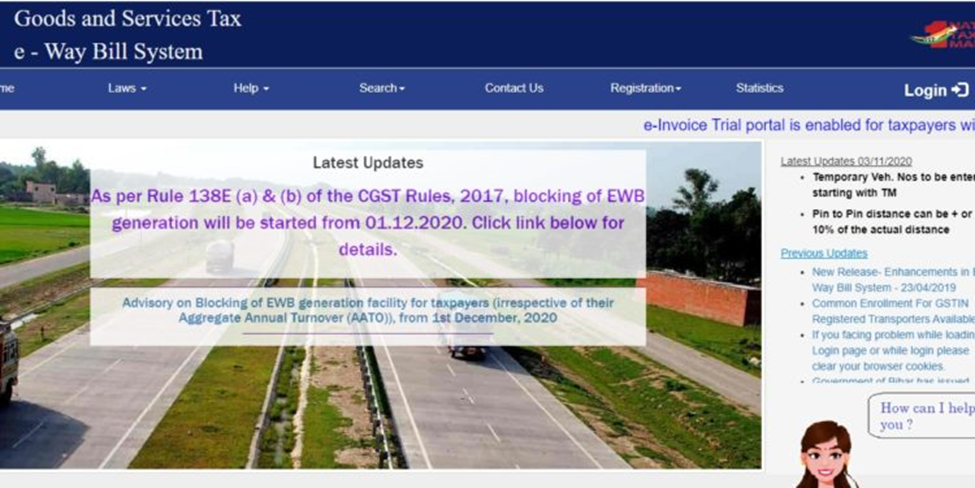
Step 2: Click “Enrolment for Transporters” under the Registration tab and you will be directed to the following Enrollment Form u/s 35(2). Fill out the form providing all the necessary information
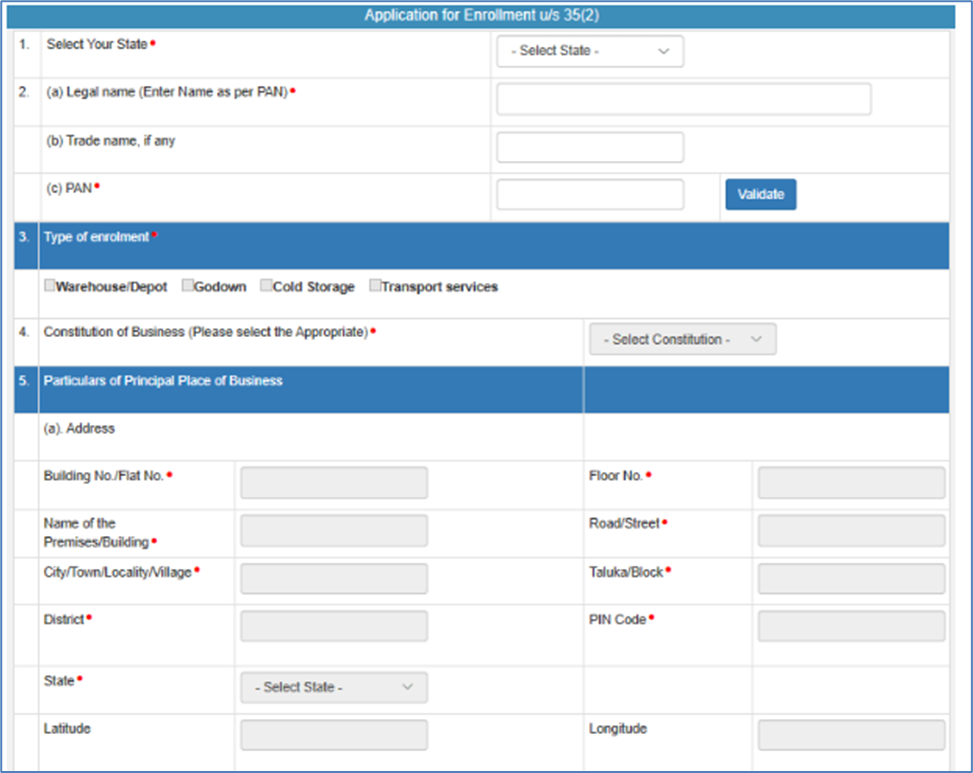
Step 3: Provide a declaration regarding the correctness of the information by clicking on the checkbox.
Step 4: Click on the “Save” button and the system will generate your 15-digit TRANS ID.
Some of the things to remember while generating e way bill for transporting goods include:
- The vehicle number and the transporter ID handling the consignments should be provided for e-way bill generation.
- If the goods are transported by a supplier in their vehicle or a hired vehicle, they must provide all the relevant details for generating the e-way bill.
- If the vehicle transporting the goods is changed while on transit, the transporter must update the details on the e-way bill portal, providing details of the new vehicle and the transporter ID.
- Finally, the e-way bill generated for a distance of 100 km is only applicable for a day. For every additional 100 km, the e-way bill will only be valid for an additional day. In addition, if the transport of the commodities cannot be completed over the specified period, the transporter must generate a new e-way bill and update all the transport details.
Entering Multiple Modes of Transportation on an e-way bill
A consignment can be transported using multiple modes of transportation before reaching the final destination. In this case, the mode of transportation will have to be updated on the e-way bill whenever there is a change from road to rail to air or sea. The changes must be made, factoring in the ‘Updated Vehicle Number’.
For instance, let’s assume we are moving a consignment from Cochin to Chandigarh through road, ship, air and road again. The transporter is required to create the e-way bill during the initial stage of movement (by road) from their location to the yard, specifying the vehicle number.
Once the goods are submitted to the shipyard, an update of the mode of transportation to the ship is made, and a new e-way bill is generated. On reaching Mumbai, the transporter must update the e-way bill mode to the road from the ship. When opting for air transport from Mumbai, the transporter needs to select the ‘update the vehicle number’ option and provide the Airway Bill number. Upon reaching Delhi, the transporter then updates the movement by road, including the vehicle number. This process ensures the e-way bill is updated to reflect multiple modes of transportation.
E-way Bill with Multiple Vehicles
There is always a likelihood that businesses with multiple locations or branches will have to transport goods using multiple vehicles. The E-way bill for multiple vehicles was enabled for this specific purpose to lessen the efforts of numerous transporters, and the option is available at the transhipment location rather than the supplier’s location.
Previously, an e-way bill had to be generated for each delivery mode for goods going to various locations using different vehicles. With the multi-vehicle update, an e-way bill can be generated, and details of the multiple conveyances that would be used can be filled in. Therefore, a consignment with one e-way bill can be transported in numerous vehicles after being shipped to the tranship location.
For instance, when a consignment needs to move from point A to point C, the business might use rail or a larger vehicle from point A to point B. On the other hand, if the area is hilly and large vehicles or railways are not available, one might opt to use smaller vehicles from point B to C.
The multi-vehicle option is typically used when:
- Goods in transit to a single destination may require the mode of transport to be broken into parts due to poor terrain, the desire to reduce travel time or other factors. In this case, goods can be transported by rail from one point to another, then offloaded and put into smaller vehicles for transportation to the final destination.
- Transporting the goods to multiple destinations, such as business branches or locations, is necessary. In this case, the supplier will deliver the e-way bill to the transporter’s warehouse. From there, it is disseminated via various vehicles for transportation to multiple locations or destinations. Consequently, the e-way bill must be updated with the remaining information on the vehicles used to transport it.
- Before the goods are moved from the supplier factory to the transporter warehouse, an e-way bill must be generated
- The multi-vehicle details must be updated before goods are sent from the transporter warehouse for distribution into various locations or branches. The e-way bill must be updated with information on all the vehicles utilized for transportation and the final destination.
Generating e way bill for Multi-Vehicle Transportation
Whenever a business has to use multiple vehicles to transport goods between various points across the country, it’s required to create a unique e-way bill. The steps for developing an e-way bill are:
Step 1: Visit the e-Way Bill Portal and Navigate to the “e-Way Bill” drop-down list and click on Change to “Multi-Vehicle.
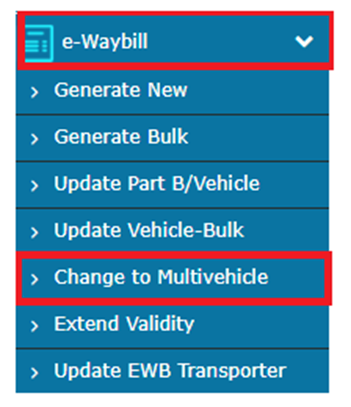
Step 2: Enter the e-Way Bill Number and click on “Go.”
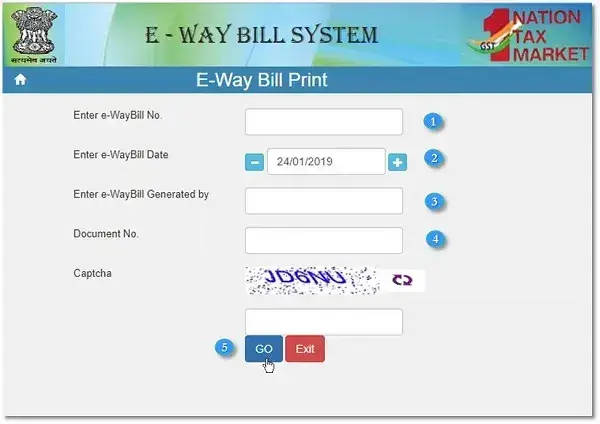
Step 3: Create a group to enter the details of transportation – destination and select mode whether it is by road, rail, air, or ship. Select “Yes” against the section “Do you wish to move goods in multiple vehicles?” Hence the multiple movement details box appears.

Source: learn.quicko.com
Step 4: Update multiple transport details. We have to enter ‘From’ and ‘To’ place, total quantity (that matches the quantity as per Invoice).

Step 5: Change to multiple vehicles
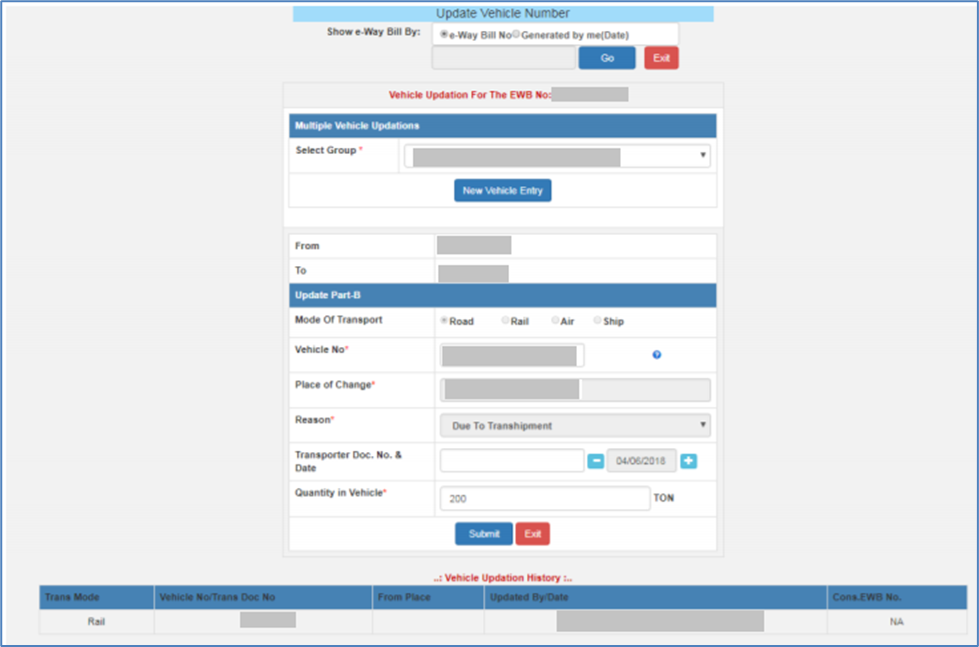
Conclusion
The Goods and Services Tax mandates any person transporting goods worth more than Rs. 50,000 to apply for an e-way bill. Generated on the GST Common Portal by registered persons or transporters, the permit details the quantity and unit measure of goods on transit from one place to another. In addition, it details the supplier, the transporter, the recipient and the mode of transport used. The permit is not applicable when transporting goods less than Rs. 50,000 in value and goods exempt from GST.
Frequently Asked Questions
1. Which documents must a transporter have while transporting goods?
The transporter is required to have either a tax invoice, bill of supply, or delivery challan, along with a duplicate of the e-way bill number generated from the common portal. This e-way bill number provides details on the quantity and unit measurement of the goods in their possession.
2. Is it a must for transporters to enroll in the e-way bill system?
Yes, it’s mandatory for transporters dealing in goods worth more than Rs. 50,000 to enroll in the e-way bill system and have a transporter ID. The only way they can do this is by creating the e-way bill for their clients or updating the vehicle number for the e-way bill when the goods are being transported from one place to another. By enrolling on the e-way bill portal, it’s possible to generate the 15-digit Unique Transporter ID.
3. Is it possible to transport the goods with an e-way bill without vehicle details?
No, it’s not possible. The e-way bill must detail the vehicle used in carrying the goods. The permit specifies the vehicle number. Nevertheless, the vehicle number is not a must when transporting goods over short distances, i.e. less than ten kilometers within the State.
4. How do you go about transporting goods using different modes of transport?
Due to differences in terrain, it’s possible to use different modes of transport to convey goods from one place to another. However, the mode of transport used at the different stages of transit should always be detailed in the e-way bill detailing the vehicle number and the transporter in charge.
5. Who is required to update the vehicle number on the e-way bill?
The transporter assigned to convey goods is the one tasked with updating the vehicle number on the e-way bill. On the other hand, the e-way bill will only be valid with the vehicle number and the transporter ID.
6. What is the Validity of an e-way Bill?
The validity of the e-way bill depends on the distance on which the goods are being transported. In this case, the permit is valid for one day for up to 100 km of the transit distance, and every 100km after that, the validity is an additional day. The validity starts when the first entry is made In Part B. The permit is valid for different types of transactions, such as supply of goods within the State or interstate or inward supply.
7. What happens when a vehicle breaks down while transporting goods?
Whenever a vehicle transporting goods gets a mechanical breakdown and can no longer transport goods, a change of vehicle is inevitable. Once the change is made, the new vehicle and transporter’s details should be entered on the e-way bill portal using the ‘Update vehicle number’ option and continue the journey with a new car.
8. What happens when the vehicle transporting goods is changed?
By law, the e-way bill should always detail the vehicle and the transporter ID transporting goods worth more than Rs. 50,000. If there is a change in the car and the transporter, the changes should be reflected in a new e-way bill permit, after which transportation of goods can commence. The transporter or the individual generating the e-way bill has the authority to update the altered vehicle number.
9. What is the penalty for not carrying an e-way bill?
A transporter found without a waybill is liable to pay a penalty of Rs. 10,000 or the equivalent tax evaded, depending on the value of the goods being transported.
10. How does a transporter know the e-way bill assigned to them?
A transporter can know the e-way bill assigned to them by going to the reports section and selecting the ‘EWB assigned to me for trans’. The transporter can also go to ‘Update Vehicle No, select Generator GSTIN, and enter the taxpayer GSTIN who has assigned the EWB to them.
11. What happens if a recipient refuses to take in goods?
There is always a chance that a recipient may refuse to accept or take goods once they are transported to them. Under such circumstances, the transporter must visit the e-way bill portal and generate a Sales Return with all the relevant document details to return the goods to the supplier.
12. When is the e-way bill exempt while transporting goods?
Transporters might not need an e-way bill while transporting goods less than Rs 50,000. In addition, the permit is not required when dealing with goods exempt from GST.